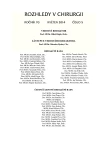Dissection and coagulation technique in thyroid surgery – is it the key to a successful outcome?
Authors:
P. Kocian; J. Neumann; P. Bavor; J. Hoch
Authors‘ workplace:
Chirurgická klinika UK 2. LF a FN v Motole, přednosta: Prof. MUDr. J. Hoch, CSc.
Published in:
Rozhl. Chir., 2014, roč. 93, č. 5, s. 255-259.
Category:
Original articles
Overview
Introduction:
This study analyzes the impact of coagulation instrument devices used during thyroid gland removal in which careful dissection and perfect haemostasis represent very important aspects. Standard electrocautery is compared to the use of bipolar forceps. The aim is to determine whether the use of different modes of coagulation is the key to the frequency and severity of postoperative complications following total thyroidectomy.
Material and methods:
This study included 82 patients undergoing total thyroidectomy with haemostasis by conventional suture ligation technique combined with monopolar electrocauterization and 36 patients undergoing total thyroidectomy with complete haemostasis by bipolar forceps. The main outcomes measured were postoperative bleeding, recurrent laryngeal nerve palsy and post-thyroidectomy hypocalcaemia and hypoparathyroidism. Patients were followed up for 6 months.
Results:
The results of our study showed that the use of bipolar forceps for vessel ligation in thyroid surgery is as safe and effective as the use of monopolar electrocautery and ligatures. Statistical analysis showed no significant differences in the rate of the individual postoperative complications between the two cohorts. Complication rates in the entire cohort were comparable with data reported in the literature.
Conclusion:
Both approaches are safe and reliable and both represent valid options. The choice might depend on the surgeon’s preferences and experience, the nature of the thyroid condition and the nature and extent of the surgical procedure.
Key words:
total thyroidectomy – postoperative bleeding – standard electrocautery, bipolar forceps – pooperative complications
Sources
1. Vassiliou I, et al. Total thyroidectomy as the single surgical option for benign and malignant thyroid disease: a surgical challenge. Arch Med Sci 2013;9 : 74–8.
2. Tresallet C, Chigot JPMenegaux F. How to prevent recurrent nerve palsy during thyroid surgery? Ann Chir 2006;131 : 149–53.
3. Dralle H, et al. Intraoperative monitoring of the recurrent laryngeal nerve in thyroid surgery. World J Surg 2008;32 : 1358–66.
4. Erbil Y, et al. Predictive factors for recurrent laryngeal nerve palsy and hypoparathyroidism after thyroid surgery. Clin Otolaryngol 2007;32 : 32–7.
5. Giordano D, et al. Complications of central neck dissection in patients with papillary thyroid carcinoma: results of a study on 1087 patients and review of the literature. Thyroid 2012;22 : 911–7.
6. Chiang FY, et al. Recurrent laryngeal nerve palsy after thyroidectomy with routine identification of the recurrent laryngeal nerve. Surgery 2005;137 : 342–7.
7. Dvořák J, et al. Detection, identification and visualization of the recurrent laryngeal nerve during thyroidectomy – still a surgical dilemma. Rozhl Chir 2002;81 : 282–9.
8. Jarošek J, et al, Surgical treatment of thyreopathies. Retrospective assessment of the authors’ study group. Rozhl Chir 2006;85 : 3–5.
9. Sturniolo G, et al. Hypocalcemia and hypoparathyroidism after total thyroidectomy: a clinical biological study and surgical considerations. Int J Surg Investig 2000;2 : 99–105.
10. Asari R, et al. Hypoparathyroidism after total thyroidectomy: a prospective study. Arch Surg 2008;143 : 132–7;discussion 138.
11. Khan MI, Waguespack SG, Hu MI. Medical management of postsurgical hypoparathyroidism. Endocr Pract 2011;17;Suppl 1 : 18–25.
12. Manouras A, et al. Novel hemostatic devices in thyroid surgery: electrothermal bipolar vessel sealing system and harmonic scalpel. Expert Rev Med Devices 2008;5 : 447–66.
13. Manouras A, et al. Thyroid surgery: comparison between the electrothermal bipolar vessel sealing system, harmonic scalpel, and classic suture ligation. Am J Surg 2008;195 : 48–52.
14. Ecker T, et al. Hemostasis in thyroid surgery: harmonic scalpel versus other techniques—a meta-analysis. Otolaryngol Head Neck Surg 2010;143 : 17–25.
15. Tysome JR, Hassan R, Davis J. Standard bipolar diathermy forceps vessel ligation is safe in thyroidectomy. Eur Arch Otorhinolaryngol 2009;266 : 1781–6.
16. Lombardi CP, et al. Complications in thyroid Sumery. Minerva Chir 2007;62 : 395–408.
17. Vach B, Fanta J, Velenská Z. The harmonic scalpel and surgery of the thyroid gland. Rozhl Chir 2002;81,Suppl 1:S3–7.
18. Kandil,E, et al. The impact of surgical volume on patient outcomes following thyroid surgery. Surgery 2013;154 : 1346-52,discussion: 1352–3.
19. Loyo M, Tufano RP, Gourin CG. National trends in thyroid surgery and the effect of volume on short-term outcomes. Laryngoscope 2013;123 : 2056–63.
Labels
Surgery Orthopaedics Trauma surgeryArticle was published in
Perspectives in Surgery

2014 Issue 5
Most read in this issue
- Complications after percutaneous transhepatic drainage of the biliary tract
- Superficial thrombophlebitis of the lower limbs from the surgeon’s point of view
- Pelvic ring injury as part of multiple trauma
- Retroperitoneal neurogenous tumors
